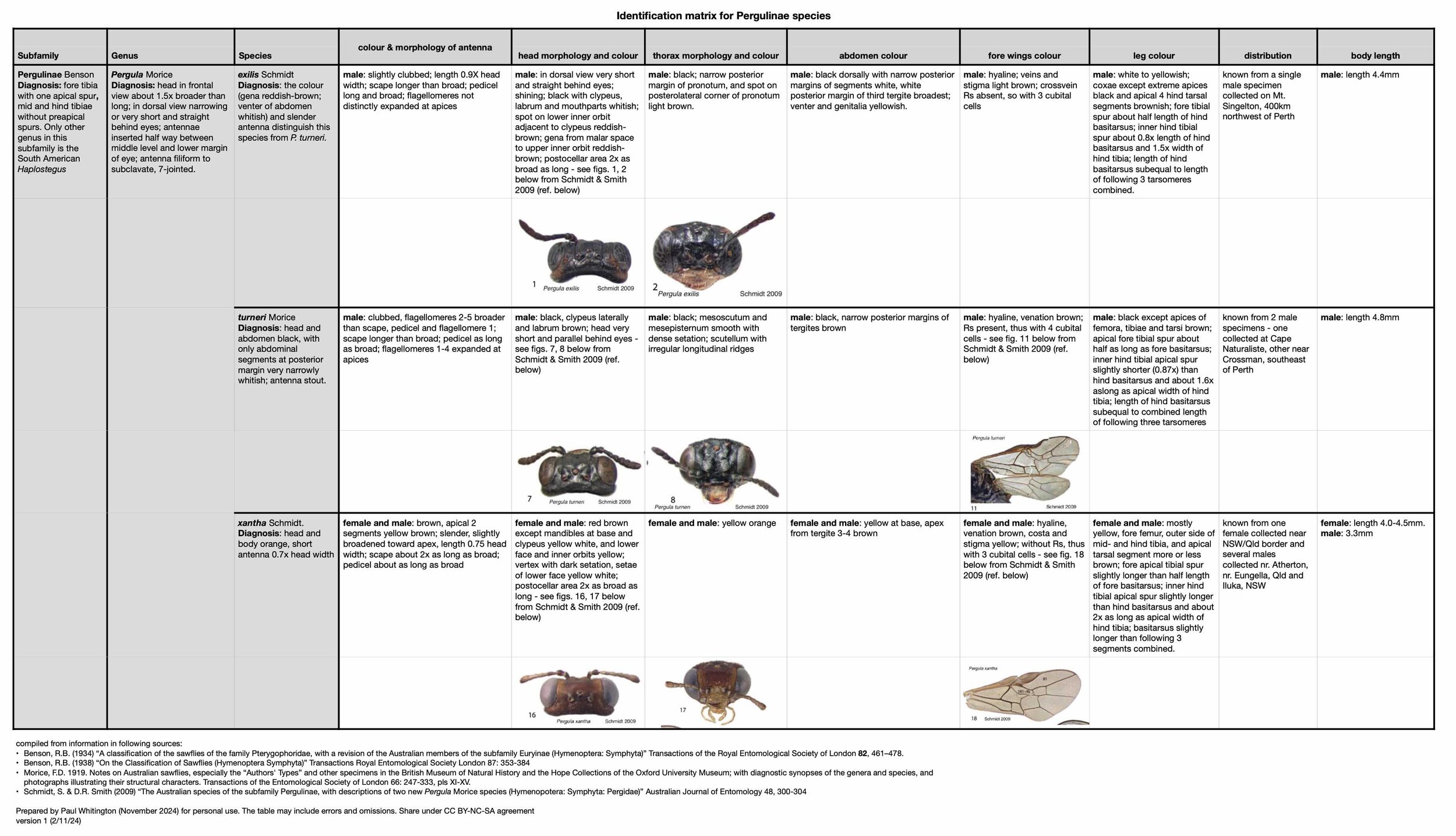The other five Pergidae subfamilies

Workbook
Note: This is a “work in progress”. Changes may be made as I discover additional relevant information.
Identification of species in other subfamilies in the family Pergidae
There are several subfamilies in the family Pergidae that are not dealt with in other notes pages - Pergulinae, Styracotechyinae, Pteryperginae, Phylacteophaginae and Philomastiginae.
The matrix below shows diagnostic features to aid recognition of each of these subfamilies.
To view iNaturalist Research Grade observations of a particular species in these other Pergidae subfamilies, click on the name of that species in the list below. (Species without a link have no RG observations at this time).
Styracotechys dicelysma Philomastix macleaii Philomastix nancarrowi Philomastix xanthophylax Pteryperga bifasciata Pteryperga galla Pteryperga hyaloptera Pergulina exilis Pergulina turneri Pergulina xantha Phylacteophaga amygdalini Phylacteophaga eucalypti Phylacteophaga froggatti Phylacteophaga occidens Phylacteophaga rubida Caloperga josephinae Leptoperga brunnea
Styracotechyinae
This subfamily contains just one species - Styracotechys dicelysma Benson
Female:
size: small (4mm long)
head: broad head, eye covers most of its length viewed dorsally; brownish-black with mouthparts and clypeus brown
antennae: 14 segments; black with 4 basal segments brown; short, flagellum about half breadth of head; inserted close to hind margin of clypeus; each flagellar segment with small pecten beneath
thorax and abdomen: orange with side lobes of mesonotum, scutellum and abdomen from middle of 4th segment blackish-brown
wings: hyaline; costa yellow; stigma and rest of venation brown
legs: yellow, except for blackish-brown hind tibiae and tarsi; with long preapical tibial spurs on middle and hind legs; apical tibial spurs exceptionally long, in hind legs longer than length of following 3 tarsal segments together
Male:
not yet formally described but Schmidt et al (2006) show a photo displaying following features -
antennae: 14 segments; blackish-brown; bipectinate and exceptionally long
thorax and abdomen: blackish-brown
legs: coxae, brown and white in all legs; femora, brownish-black, with apex white in fore and mid legs and base white in hind legs; tibiae and tarsi, white in fore and mid legs, blackish-brown in hind legs
The remaining subfamilies - Pergulinae, Pteryperginae, Phylacteophaginae and Philomastiginae - all have more than one species. The matrices below are designed to aid identification of their genera and species.
Click on each matrix to download a pdf version. Images from authoritative sources of selected species follow as a further aid.
Philomastiginae
Philomastix macleaii = Philomastix glabra
Philomastix nancarrowi
Philomastix xanthophylax
Pteryperginae
Pergulinae
Phylacteophaginae
References:
Benson, R.B. (1934) “A classification of the sawflies of the family Pterygophoridae, with a revision of the Australian members of the subfamily Euryinae (Hymenoptera: Symphyta)” Transactions of the Royal Entomological Society of London 82: 461–478.
Benson, R.B. (1935) “New Australian Sawflies (Hymenoptera, Symphyta)” Memoirs of Queensland Museum 10: 211-229.
Benson, R.B. (1938) “On the Classification of Sawflies (Hymenoptera Symphyta)” Transactions Royal Entomological Society London 87: 353-384.
Benson, R.B. (1938) '“Sawflies of the Subfamily Trichorhachinæ (Argidæ) (Hymenoptera, Symphyta)” Annals and Magazine of Natural History, 2:8, 117-122.
Benson, R.B. (1938) “A revision of the genus Pterygophorus Klug, sensu lato, with the descriptions of two new genera (Hymenoptera, Symphyta). J. Nat. History. 1: 610-625.
Brullé, A. (1846) “Hyménoptères” in Lepeletier, Histoire Naturelle des Insectes. v.4. Paris: Roret.
Froggatt, W.W. (1899) “A new genus and species of sawfly”. Proc. Linn. Soc. NSW 24: 130-134.
Froggatt, W.W. (1907) “Australian Insects” Brooks & Company Ltd. Sydney.
Kirby, W.F. (1882) “List of Hymenoptera, with descriptions and figures of the typical specimens in the British Museum. Vol. I. Tenthredinidae and Siricidae”. London: British Museum.
Mayo, G.M., Austin, A.D. & Adams, M. (1997) “Morphological and electrophoretic taxonomy of the Australian eucalypt leaf-blister sawfly genus Phylacteophaga (Hymenoptera: Pergidae): a potential major pest group of eucalyts worldwide” J. Ent. Res. 87: 595-608.
Morice, F.D. (1919) “Notes on Australian sawflies, especially the “Authors' Types” and other specimens in the British Museum of Natural History and the Hope Collections of the Oxford University Museum; with diagnostic synopses of the genera and species, and photographs illustrating their structural characters.” Transactions of the Entomological Society of London 66: 247-333, pls XI-XV.
Naumann, I.D. (1983) “A new genus of Phylacteophaginae from Northern Australia with a key to the genera of the subfamily (Hymenoptera: Tenthredinoidea: Pergidae)” J. Aust. Ent. Soc. 22:237-242.
Riek, E.F. (1955) “Australian leaf-mining sawflies of the genus Phylacteophaga (Hymenoptera, Tenthredinidae)”. Aust. J. Zool. 3: 95-98.
Riek, E.F. (1970) “A redefinition of the subfamily Phylacteophaginae with description of a new genus and species (Hymenoptera: Symphyta: Pergidae)”. J. Aust. Ent. Soc. 9: 215-218.
Schmidt, S. & D.R. Smith (2009) “The Australian species of the subfamily Pergulinae, with descriptions of two new Pergula Morice species (Hymenopotera: Symphyta: Pergidae)” Australian Journal of Entomology 48, 300-304.
Schmidt, S., Walter, G.H., Grigg, J. & Moore, C.J. (2006) “Sexual Communication and Host Plant Associations of Pergidae” in Recent Sawfly Research: Synthesis and Prospects. Blank, S.M. et al. Goecke & Evers, Keltern.
Schmidt, S., Smith, D.R. & Macdonald, J. (2002) “Review of the Australian Subfamily Pteryperginae (Hymenoptera: Symphyta: Pergidae)”. J. Hymenoptera Res. 11: 134-141.
Westwood, J.O. 1841. “Descriptions of some exotic species of sawflies.” Arcana Entomologica p.23.
This is a workbook page … a part of our website where we record the observations and references used in making species identifications. The notes will not necessarily be complete. They are a record for our own use, but we are happy to share this information with others.



























